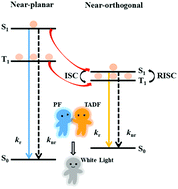Thermally activated delayed fluorescence emitters with dual conformations for white organic light-emitting diodes: mechanism and molecular design†
Abstract
Thermally activated delayed fluorescence (TADF) molecules with dual emission have great potential for use as single emitters in white organic light-emitting diodes (WOLEDs). In this paper, the light-emitting mechanisms of PTZ-TTR and PTZ-Ph-TTR with blue-orange dual emission are studied systematically. The near-planar and near-orthogonal conformations are responsible for the blue and orange emission, respectively. For PTZ-TTR, the near-orthogonal conformation is only generated by the transformation from the near-planar conformation, while the near-orthogonal conformation of PTZ-Ph-TTR can be generated by both excitation and transformation. This results in relatively strong orange emission in PTZ-Ph-TTR. In addition, the TADF mechanism is investigated, and two up-conversion pathways are revealed for both molecules. Based on the comparison of the photophysical properties of PTZ-TTR in toluene and the aggregation state, we find that aggregation could induce a smaller energy gap between the first singlet excited state and the first triplet excited state. Besides, the substitution effect of donors on light-emitting properties is studied, and the design rules for emitters with dual conformations and compensatory emission are proposed. Our theoretical results would favor the understanding of the light-emitting mechanism as well as the design of new-type TADF emitters for WOLEDs.



 Please wait while we load your content...
Please wait while we load your content...